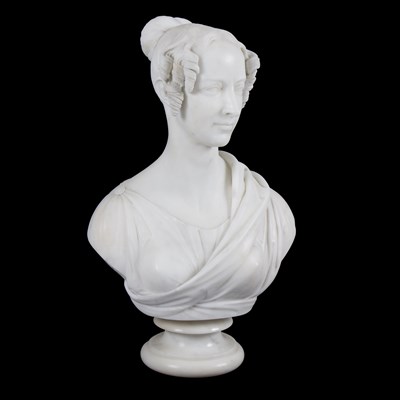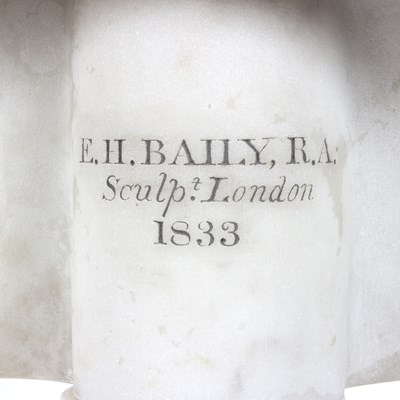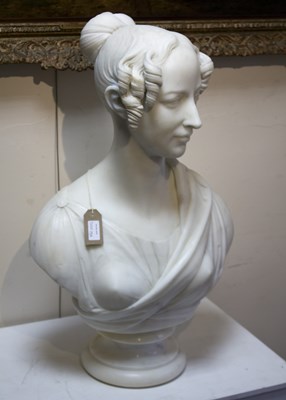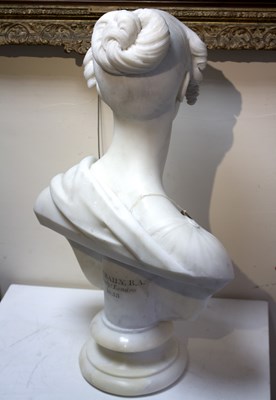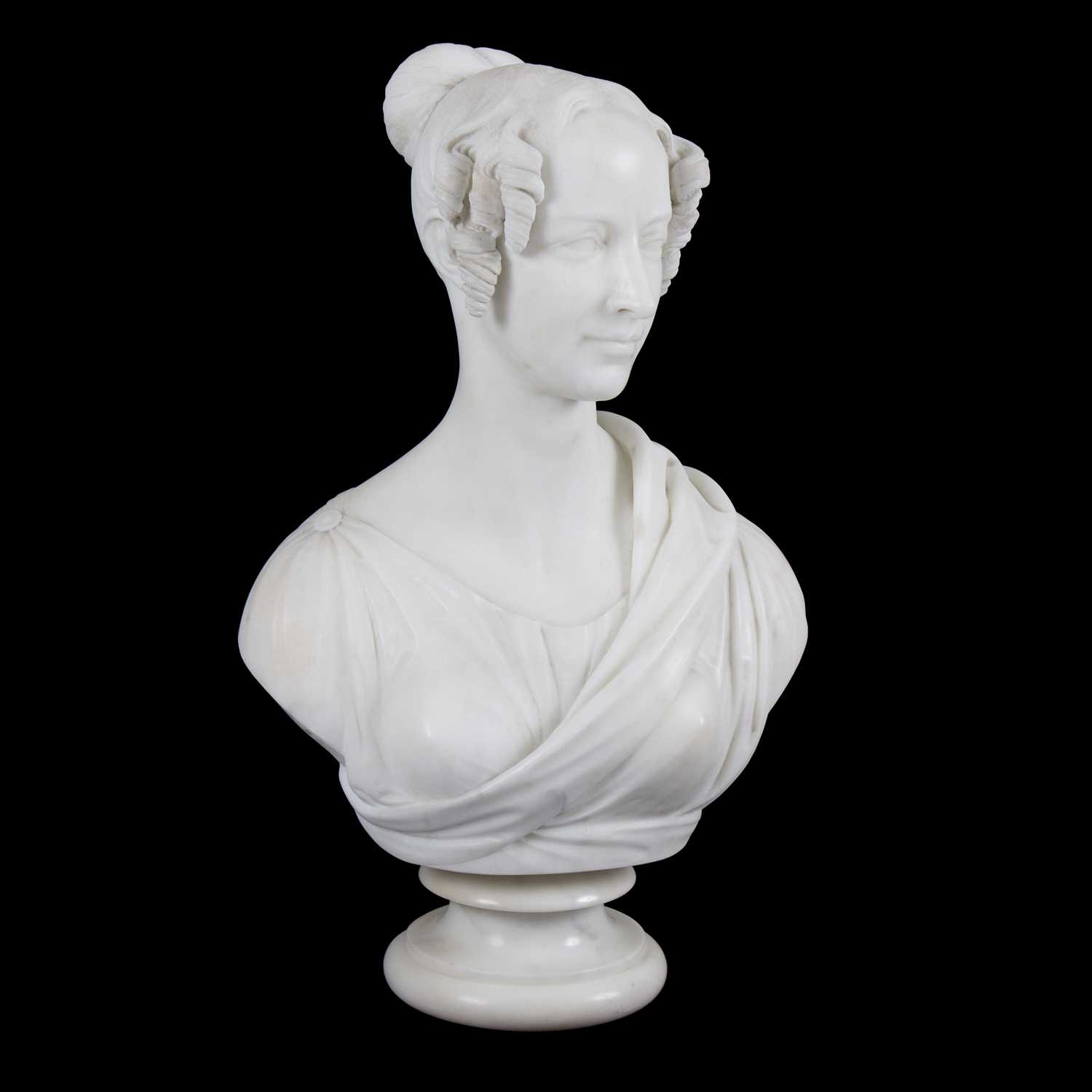20th Nov, 2018 10:00
Fine Art & Antiques
754
Edward Hodges Baily RA (1788-1867)/Marble bust of Lady Mary Spring-Rice (later Lady Aubrey de Vere)/on a circular socle, 76cm high, signed E H Baily, R A Sculp, London, 1833/Exhibited in the Royal Academy in 1834 (RA1934, 1082) Provenance: The de Vere family trust to present owner Marble bust of Lady Aubrey de Vere Aubrey de Vere was a great admirer of Edward Hodges Baily and purchased several of his works, amongst these was the present bust (the bust was referred to in Riddel's archive on Baily). There is correspondence from de Vere's son, Sir Stephen de Vere (1812 - 1904) dated 1883 in which he discussed his father's Mother and Child group, then still in the family collection he says "My Father had the greatest admiration for Mr Baily's genius as an artist and the most profound respect and esteem for him personally. I can remember him as a guest at my Father's house in London in 1821". Referring to the present bust he says "I have found in my late Father's accounts an entry of a cheque to EBH in September 1834 which must be for the bust of Lady de Vere", (see the Baily papers f. 96). Lady Mary Spring-Rice (later Lady Aubrey de Vere): Mary Rice was born c.1787, the daughter of Stephen Rice and Catherin Spring she married the celebrated poet and school friend of Lord Byron, Sir Aubrey de Vere in 1807 when she was only 18 years old, they had eight children. She died on the 11th February 1856. In her younger days she was one of Queen Victoria's Maids of Honour (1837 to 1841). Mary attended the Queen's Coronation on the 28th June 1838 and was appreciated very much by Prince Albert for their conversation in German. The Queen rather unkindly observed however that she was more clever than good looking. Edward Hodges Baily: Baily was born in Downend, Bristol and was considered the greatest exponent of 'ideal' sculpture in mid-nineteenth Century England. The son of a ship carver, Baily never travelled abroad or visited Rome but had a natural aptitude for modelling. He began his career in a merchant's counting house, but took lessons from a wax modeller, leaving the counting house after only two years to pursue the arts. A young surgeon named Leigh recognised his talent, lending him two of the artist John Flaxman's designs and commissioning Baily to make models for them. Leigh was so impressed by these that he showed then to Flaxman. Baily soon joined Flaxman's studio and remained there for seven years and reportedly became Flaxman's favourite assistant. Flaxman provided designs to Rundell & Bridge and through him Baily began to work for the company in 1815, transporting Flaxman's designs into models. Baily stayed with Rundell & Bridge as a designer and modeller for nearly twenty years, until 1833 when he joined the rival firm Hunt & Roskill. It was during this period that the sculptor made the acquaintance of Joseph Neeld. In 1808 Baily joined the Royal Academy School and in 1811 he won a gold medal and a prize of 50 guineas for his Hercules Rescuing Alcestis from Orcas. Baily's models for silverware and his large-scale sculptures were closely related with perhaps his most famous sculpture, Eve at the Fountain, originally conceived as a handle for a soup-tureen. A marble version of this was also displayed at Grittleton. Although Baily's sculptural practice included commissions for funerary monuments and portrait busts this was not where his heart lay. His rival Francis Chantrey far outstripped him in these lucrative genres and Baily's pursuit of 'ideal' sculpture and his somewhat extravagant lifestyle led the sculptor into financial ruin. He was declared bankrupt in 1831 and again in 1838, when he was imprisoned. His creditors forced him to put up some of his 'idea' sculptures for sale by lottery. Joseph Neeld came to his rescue and purchased one of them, Maternal Affection (1837) for Grittleton. This work is now in the Victoria and Albert Museum. The relationship between artist and patron turned Baily's fortunes around and enabled the sculptor to create some of his most important and critically recognised works, culminating in one of the most iconic sculptures in London, the figure of Nelson on top of the famous column in Trafalgar Square, completed in 1843.
Sold for £6,000
Edward Hodges Baily RA (1788-1867)/Marble bust of Lady Mary Spring-Rice (later Lady Aubrey de Vere)/on a circular socle, 76cm high, signed E H Baily, R A Sculp, London, 1833/Exhibited in the Royal Academy in 1834 (RA1934, 1082) Provenance: The de Vere family trust to present owner Marble bust of Lady Aubrey de Vere Aubrey de Vere was a great admirer of Edward Hodges Baily and purchased several of his works, amongst these was the present bust (the bust was referred to in Riddel's archive on Baily). There is correspondence from de Vere's son, Sir Stephen de Vere (1812 - 1904) dated 1883 in which he discussed his father's Mother and Child group, then still in the family collection he says "My Father had the greatest admiration for Mr Baily's genius as an artist and the most profound respect and esteem for him personally. I can remember him as a guest at my Father's house in London in 1821". Referring to the present bust he says "I have found in my late Father's accounts an entry of a cheque to EBH in September 1834 which must be for the bust of Lady de Vere", (see the Baily papers f. 96). Lady Mary Spring-Rice (later Lady Aubrey de Vere): Mary Rice was born c.1787, the daughter of Stephen Rice and Catherin Spring she married the celebrated poet and school friend of Lord Byron, Sir Aubrey de Vere in 1807 when she was only 18 years old, they had eight children. She died on the 11th February 1856. In her younger days she was one of Queen Victoria's Maids of Honour (1837 to 1841). Mary attended the Queen's Coronation on the 28th June 1838 and was appreciated very much by Prince Albert for their conversation in German. The Queen rather unkindly observed however that she was more clever than good looking. Edward Hodges Baily: Baily was born in Downend, Bristol and was considered the greatest exponent of 'ideal' sculpture in mid-nineteenth Century England. The son of a ship carver, Baily never travelled abroad or visited Rome but had a natural aptitude for modelling. He began his career in a merchant's counting house, but took lessons from a wax modeller, leaving the counting house after only two years to pursue the arts. A young surgeon named Leigh recognised his talent, lending him two of the artist John Flaxman's designs and commissioning Baily to make models for them. Leigh was so impressed by these that he showed then to Flaxman. Baily soon joined Flaxman's studio and remained there for seven years and reportedly became Flaxman's favourite assistant. Flaxman provided designs to Rundell & Bridge and through him Baily began to work for the company in 1815, transporting Flaxman's designs into models. Baily stayed with Rundell & Bridge as a designer and modeller for nearly twenty years, until 1833 when he joined the rival firm Hunt & Roskill. It was during this period that the sculptor made the acquaintance of Joseph Neeld. In 1808 Baily joined the Royal Academy School and in 1811 he won a gold medal and a prize of 50 guineas for his Hercules Rescuing Alcestis from Orcas. Baily's models for silverware and his large-scale sculptures were closely related with perhaps his most famous sculpture, Eve at the Fountain, originally conceived as a handle for a soup-tureen. A marble version of this was also displayed at Grittleton. Although Baily's sculptural practice included commissions for funerary monuments and portrait busts this was not where his heart lay. His rival Francis Chantrey far outstripped him in these lucrative genres and Baily's pursuit of 'ideal' sculpture and his somewhat extravagant lifestyle led the sculptor into financial ruin. He was declared bankrupt in 1831 and again in 1838, when he was imprisoned. His creditors forced him to put up some of his 'idea' sculptures for sale by lottery. Joseph Neeld came to his rescue and purchased one of them, Maternal Affection (1837) for Grittleton. This work is now in the Victoria and Albert Museum. The relationship between artist and patron turned Baily's fortunes around and enabled the sculptor to create some of his most important and critically recognised works, culminating in one of the most iconic sculptures in London, the figure of Nelson on top of the famous column in Trafalgar Square, completed in 1843.
Auction: Fine Art & Antiques, 20th Nov, 2018
